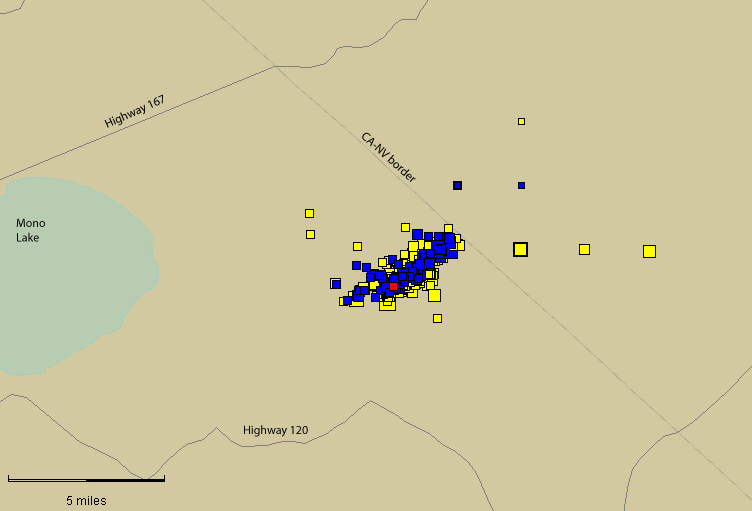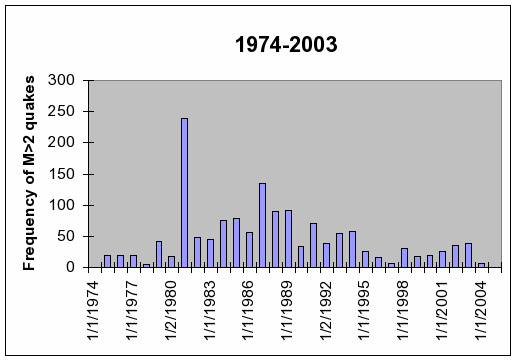

The “Adobe Hills swarm” is named after a topographic feature in the vicinity of this sequence. Seismologists refer to this sequence as a swarm for several reasons. Unlike a typical mainshock-aftershock sequence, there is no obvious mainshock in this sequence. As of 9/20/2004, the largest event, a M5.5 quake, occurred nearly 16 hours after the sequence began. By then, more than 31 earthquakes had been located. The USGS Quaternary Faults and Fold Database of the United States shows few mapped faults in the epicentral region, but those to the vicinity are referred to as Huntoon Valley fault system. These faults are Late Quaternary (<15 Ka) in age and have a strike of N48°E with sinistral and normal sense of motion. This trend of the mapped faults is similar to the trend of seismicity and to the left-lateral planes in the moment tensor solutions of the larger events.

|
| This image is a screenshot from CISN Display, showing seismicity in the last hour (red), last day (blue) and last week (yellow) as of 03:00 PM on September 20th |
Historically the region to the east between this sequence and the north shore of Mono Lake has been quite seismically active. Since 1974, the CISN (California Integrated Seismic Network) has located more than 3,200 quakes within the box defined by latitude 37.85º – 38.15º, longitude -119.25º – -118.5º. During the past 20 years 170 quakes had magnitudes that exceeded 3.0.

During the 1980’s this fault system was quite active. A swarm began June 29, 1980 with a M4.6 quake. The sequence developed into a long-lived swarm that gradually died out by the end of the year. During that sequence 75 quakes were located with magnitudes above 3.0. The system picked up again in mid-1980’s abated somewhat by 1995, but continued on at moderate levels until this sequence. Seismologists do not know when the Adobe Hills sequence will end, but if past behavior is any guide, it could persist for weeks to months.
While the swarm behavior of the Adobe Hills sequence and its proximity to the Mono-Inyo craters and Long Valley volcanic field allows a volcanic origin, there is little geophysical instrumentation in the region to support or refute this hypothesis. Geologists have mapped basaltic cinder cones in the vicinity of this Adobe Hills sequence, but they have not erupted in the past 3 million years. While swarm activity is sometimes associated with volcanic unrest, swarms also occur in non-volcanic areas. Of particular note are the swarms that occur every few years in the vicinity of Dublin, CA in the eastern San Francisco Bay region. The USGS is temporarily deploying GPS equipment in the region to detect any anomalous deformation that could be attributed to volcanic origins. (Meanwhile, the status at Long Valley caldera remains “green”.)